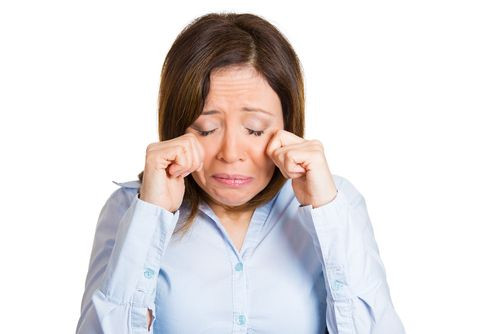Crying and Perimenopause Go Hand In Hand, And Now Brain Researchers Discover Why

It is a frequently quoted statistic that roughly one in every four women (23 percent) between the ages of 40 and 59 take antidepressants. This age group includes both perimenopause, the stage leading up to menopause when a woman’s period ends — commonly, sometime between ages 40 and 55 — to the earliest years of menopause itself.
Now, a new study finds perimenopausal women have higher levels of a brain protein linked to depression when compared to either younger or older women. These findings may explain the high rates of first-time depression among women in this age group. "This is the first time that a biological change in the brain has been identified in perimenopause which is also associated with clinical depression," said Dr. Jeffrey Meyer, senior scientist at the Centre for Addiction and Mental Health, Canada's largest mental health and addiction teaching hospital.
The average age of menopause is 51, according to WomensHealth.gov. Perimenopause refers to the time leading up to a woman's last period when changes in a woman’s cycle begin to occur. During this transition stage, which may last anywhere from two to eight years, periods may stop and then start up again and because of these shifting tides, a woman is not considered to be in menopause until at least a year has passed since her last period. During perimenopause, levels of both estrogen and progesterone, two female hormones made in the ovaries, begin to plummet, while many women experience mood changes, complete with crying jags. First-time diagnoses of clinical depression reach rates of 16 to 17 percent for women "undergoing the change," while a similar proportion are diagnosed with milder depressive symptoms.
Monoamine oxidase A (MAO-A) is an important brain enzyme, the density of which may become elevated once estrogen levels begin to decline during perimenopause. MAO-A breaks down brain chemicals, including serotonin, norepinephrine, and dopamine, all of which help to maintain normal mood. Meyer and his research team have previously linked high levels of MAO-A to major depressive disorder, depressed mood related to alcohol dependence, and the period following childbirth.
To understand if MAO-A levels may explain the mood changes during perimenopause, Meyer and his research team investigated whether that brain enzyme’s density increases in women between the ages of 41 and 51. The women fell into three groups: 19 were of reproductive age, 27 were in perimenopause, and 12 were in menopause. The research team scanned the brains of the three separate groups of women using positron emission tomography (PET). What did Meyer and his team discover? On average, levels of MAO-A were 34 percent higher in the perimenopausal group of women than their younger counterparts, and 16 percent higher than the women in menopause. The perimenopausal women also reported a higher tendency to cry, which was associated with high MAO-A levels in the front part of the brain, the prefrontal cortex.
The researchers had also predicted that MAO-A levels would drop during menopause, once fluctuating levels of estrogen stabilized, and this also proved to be the case.
The results suggest new opportunities for prevention. Meyer explained in a press release that one approach may be a dietary supplement, which he is currently investigating in another study of women after childbirth, to prevent post-partum depression. Another approach may be to offer hormone replacement therapy (HRT) at an earlier stage to prevent the fluctuation of estrogen levels, which is also linked to higher amounts of MAO-A.
Source: Meyer JH, Rekkas PV, Wilson AA, et al. Greater Monoamine Oxidase A Binding in Perimenopausal Age as Measured With Carbon 11–Labeled Harmine Positron Emission Tomography. JAMA Psychiatry. 2014.



























